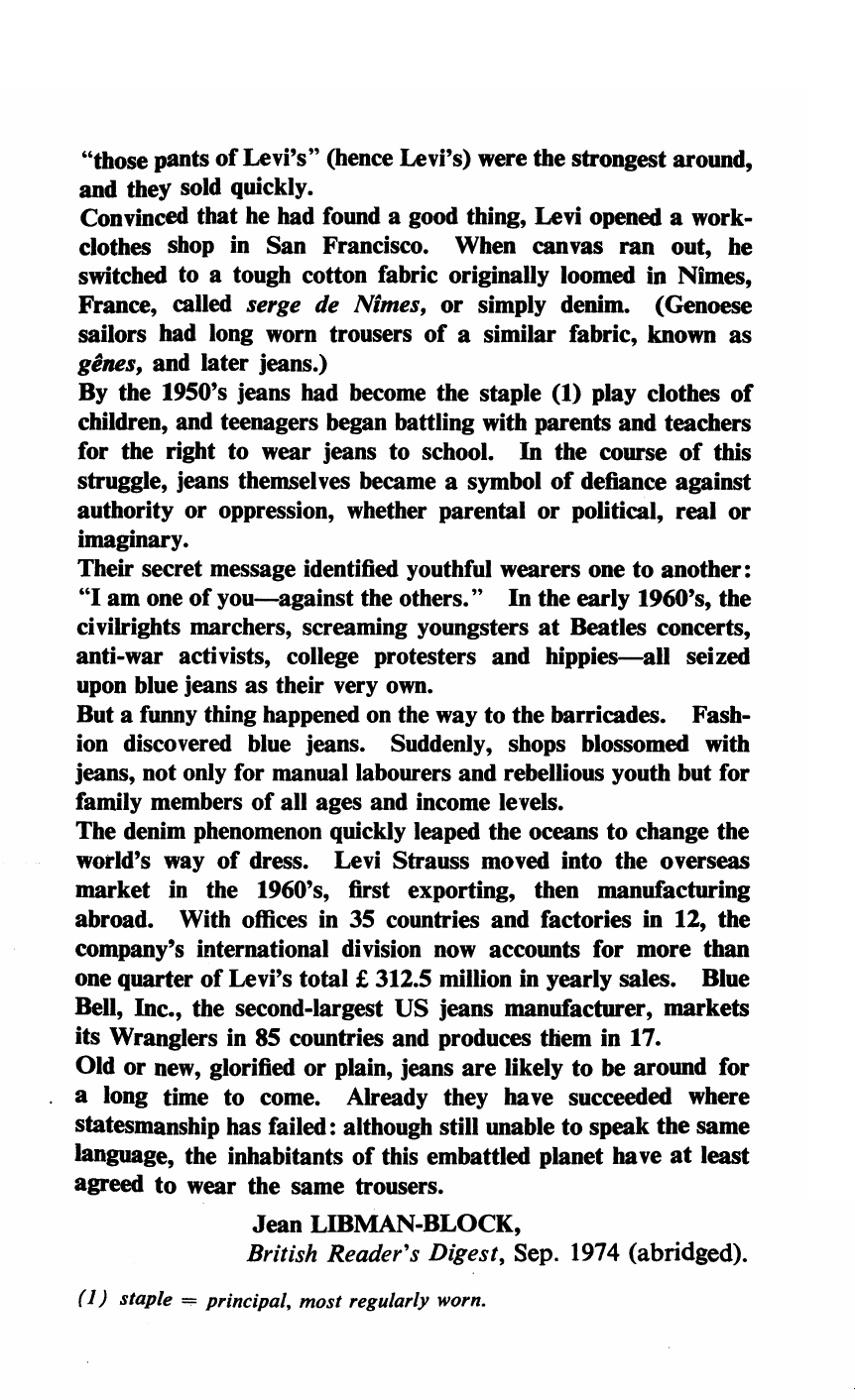JEANS ARE FOR EVERYBODY
Publié le 07/02/2012

Extrait du document
The world is in the grip of a blue-jeans frenzy. Once the nononsense work trousers of farmers-foresters and miners-and few others-jeans now strut, stride, stroll and slouch (1) everywhere. In 1850, Levi Strauss, a 20-year-old Bavarian emigrant, arrived in San Francisco to seek his fortune in the gold fields. He brought with him a stock of dry goods (2), including some beavy brown canvas, which he planned to sell to miners for tents and wagon covers. Tents, he soon found, were not in demand, but few miners bad clothes sturdy enough to stand up to their rough working life. The enterprising young man employed a tailor to make trousers out of his rugged can vas. Word spread that
«
"those pants of Levi's" (bence Levi's) were the strongest around,
and they sold quickly.
Convinced that he bad found a good thing, Levi opened a work
clothes shop
in San Francisco.
When canvas ran out, he
switched to a tough cotton fabric originally loomed in Nimes,
France, called
serge de Nîmes, or simply denim.
(Genoese
sailors bad long worn trousers
of a similar fabric, known as
gênes, and later jeans.)
By
the 1950's jeans bad become the staple (1) play clothes of
children, and teenagers began battling with parents and teachers
for the right to wear jeans to school.
In the course of this
struggle, jeans themselves became a symbol
of defiance against
authority or oppression, whether parental or political, real or
imaginary.
Their secret message identified youthful wearers one to another:
"1 am one of you-against the others." In the early 1960's, the
ci vilrights marchers, screaming youngsters
at Beatles concerts,
anti-war activists, college protesters and hippies-aU seized
upon blue jeans as their very
own.
But a funny thing happened on the way to the barricades.
Fash
ion discovered blue jeans.
Suddenly, shops blossomed with
jeans, not only for manuallabourers and rebellious youth but for
family members
of ali ages and income levels.
The denim phenomenon quickly leaped the oceans to change the
world's
way of dress.
Levi Strauss moved into the overseas
market
in the 1960's, first exporting, then manufacturing
abroad.
With offices
in 35 countries and factories in 12, the
company's international division
now accounts for more than
one quarter
of Levi's total f, 312.5 million in yearly sales.
Blue
Bell, Inc., the second-largest
US jeans manufacturer, markets
its Wranglers
in 85 countries and produces them in 17.
Old or new, glorified or plain, jeans are likely to be around for
a long time to come.
Already they have succeeded where
statesmanship bas failed: although still unable to speak the same
language, the inhabitants
of this embattled planet have at least
agreed to wear the same trousers.
Jean LffiMAN-BLOCK,
British Reader's Digest, Sep.
1974 (abridged).
( 1) staple = principal, most regularly worn..
»
↓↓↓ APERÇU DU DOCUMENT ↓↓↓
Liens utiles
- Tom Jones (1749) Henry Fielding Book I -- Chapter 1 An author ought to consider himself, not as a gentleman who gives a private or eleemosynary treat, but rather as one who keeps a public ordinary, at which all persons are welcome for their money.
- Debating Sports Records Mark Purdy, sports columnist for the San Jose Mercury News in California, compiles a list of sports records that he believes will never be broken and a separate list of records that he thinks are soon to be eclipsed.
- Steven Spielberg I INTRODUCTION Steven Spielberg The imaginative films of Steven Spielberg are known for their technical creativity and memorable characters.
- Temperature I INTRODUCTION Thermometers Mercury and digital thermometers are the most common types of household devices for measuring body temperature.
- Debating Sports Records Mark Purdy, sports columnist for the San Jose Mercury News in California, compiles a list of sports records that he believes will never be broken and a separate list of records that he thinks are soon to be eclipsed.











